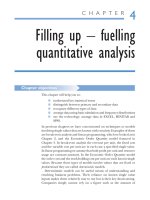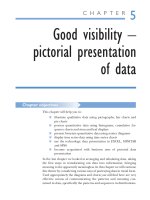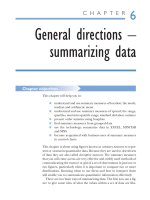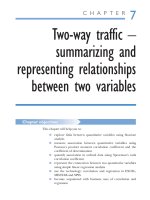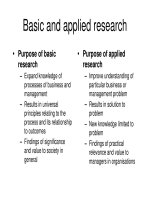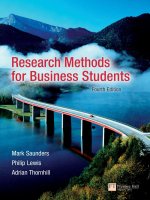Research methods for business 5th ch5
Bạn đang xem bản rút gọn của tài liệu. Xem và tải ngay bản đầy đủ của tài liệu tại đây (538.71 KB, 38 trang )
Slide 5.1
Chapter 5
Formulating the research design
Saunders, Lewis and Thornhill, Research Methods for Business Students, 5th Edition, © Mark Saunders, Philip Lewis and Adrian Thornhill 2009
Slide 5.2
Saunders, Lewis and Thornhill, Research Methods for Business Students, 5th Edition, © Mark Saunders, Philip Lewis and Adrian Thornhill 2009
Slide 5.3
The Process of Research Design
• Research choices
• Research strategies
• Time horizons
Saunders, Lewis and Thornhill, Research Methods for Business Students, 5th Edition, © Mark Saunders, Philip Lewis and Adrian Thornhill 2009
Slide 5.4
Research Design and Tactics
The research onion
Figure 5.1 The research ‘onion’
Saunders et al, (2009)
Saunders, Lewis and Thornhill, Research Methods for Business Students, 5th Edition, © Mark Saunders, Philip Lewis and Adrian Thornhill 2009
Slide 5.5
Research Design
The research design needs
• Clear objectives derived from the research
question
• To specify sources of data collection
• To consider constraints and ethical issues
• Valid reasons for your choice of design
Saunders, Lewis and Thornhill, Research Methods for Business Students, 5th Edition, © Mark Saunders, Philip Lewis and Adrian Thornhill 2009
Slide 5.6
Saunders, Lewis and Thornhill, Research Methods for Business Students, 5th Edition, © Mark Saunders, Philip Lewis and Adrian Thornhill 2009
Slide 5.7
Saunders, Lewis and Thornhill, Research Methods for Business Students, 5th Edition, © Mark Saunders, Philip Lewis and Adrian Thornhill 2009
Slide 5.8
Saunders, Lewis and Thornhill, Research Methods for Business Students, 5th Edition, © Mark Saunders, Philip Lewis and Adrian Thornhill 2009
Slide 5.9
Saunders, Lewis and Thornhill, Research Methods for Business Students, 5th Edition, © Mark Saunders, Philip Lewis and Adrian Thornhill 2009
Slide 5.10
Saunders, Lewis and Thornhill, Research Methods for Business Students, 5th Edition, © Mark Saunders, Philip Lewis and Adrian Thornhill 2009
Slide 5.11
Saunders, Lewis and Thornhill, Research Methods for Business Students, 5th Edition, © Mark Saunders, Philip Lewis and Adrian Thornhill 2009
Slide 5.12
Saunders, Lewis and Thornhill, Research Methods for Business Students, 5th Edition, © Mark Saunders, Philip Lewis and Adrian Thornhill 2009
Slide 5.13
Saunders, Lewis and Thornhill, Research Methods for Business Students, 5th Edition, © Mark Saunders, Philip Lewis and Adrian Thornhill 2009
Slide 5.14
Saunders, Lewis and Thornhill, Research Methods for Business Students, 5th Edition, © Mark Saunders, Philip Lewis and Adrian Thornhill 2009
Slide 5.15
Saunders, Lewis and Thornhill, Research Methods for Business Students, 5th Edition, © Mark Saunders, Philip Lewis and Adrian Thornhill 2009
Slide 5.16
Saunders, Lewis and Thornhill, Research Methods for Business Students, 5th Edition, © Mark Saunders, Philip Lewis and Adrian Thornhill 2009
Slide 5.17
Saunders, Lewis and Thornhill, Research Methods for Business Students, 5th Edition, © Mark Saunders, Philip Lewis and Adrian Thornhill 2009
Slide 5.18
Saunders, Lewis and Thornhill, Research Methods for Business Students, 5th Edition, © Mark Saunders, Philip Lewis and Adrian Thornhill 2009
Slide 5.19
Classification of the research purpose
Exploratory research
is a valuable means
of finding out ‘what is happening to seek new
insights; to ask questions and to assess
phenomena in a new light’. It is particularly
useful if you wish to clarify your
understanding of a problem, such as if you
are unsure of precise nature of the problem .
It may well be that time is well spent on
exploratory research, as it may show that the
research is not worth pursuing!
Saunders, Lewis and Thornhill, Research Methods for Business Students, 5th Edition, © Mark Saunders, Philip Lewis and Adrian Thornhill 2009
Slide 5.20
Explanatory
• There are three principal ways of conducting
explanatory research:
• A search of the literature;
• Interviewing ‘experts’ in the subject;
• Conducting focus group interviews.
Saunders, Lewis and Thornhill, Research Methods for Business Students, 5th Edition, © Mark Saunders, Philip Lewis and Adrian Thornhill 2009
Slide 5.21
Descriptive studies
• The object of descriptive research is ‘ to
‘portray an accurate profile of persons,
events or situations’. This may be an
extension of, or a forerunner to a piece of
exploratory research or, more often, a
piece of explanatory research. It is
necessary to have a clear picture of the
phenomena on which you wish to collect
data prior to collection of data.
Saunders, Lewis and Thornhill, Research Methods for Business Students, 5th Edition, © Mark Saunders, Philip Lewis and Adrian Thornhill 2009
Slide 5.22
Explanatory research
• Studies that establish causal relationships
between variables may be termed
explanatory research. The emphasis her is
on studying a situation or a problem in order
to explain the relationship between variables.
For example, that a cursory analysis of
quantitative data on manufacturing scrap
rates shows a relationship between scrap
rates and the age of machine being operated
Saunders, Lewis and Thornhill, Research Methods for Business Students, 5th Edition, © Mark Saunders, Philip Lewis and Adrian Thornhill 2009
Slide 5.23
Research Strategies
Experiment
Action research
Grounded theory
Ethnography
Survey
Case study
Archival research
Saunders, Lewis and Thornhill, Research Methods for Business Students, 5th Edition, © Mark Saunders, Philip Lewis and Adrian Thornhill 2009
Slide 5.24
Research Strategies
An experiment will involve
•
•
•
•
•
Definition of a theoretical hypothesis
Selection of samples from know populations
Random allocation of samples
Introduction of planned intervention
Measurement on a small number of
dependent variables
• Control of all other variables
Saunders, Lewis and Thornhill, Research Methods for Business Students, 5th Edition, © Mark Saunders, Philip Lewis and Adrian Thornhill 2009
Slide 5.25
Research Strategies
Survey: key features
•
•
•
•
•
•
•
Popular in business research
Perceived as authoritative
Allows collection of quantitative data
Data can be analysed quantitatively
Samples need to be representative
Gives the researcher independence
Structured observation and interviews can be
used
Saunders, Lewis and Thornhill, Research Methods for Business Students, 5th Edition, © Mark Saunders, Philip Lewis and Adrian Thornhill 2009



